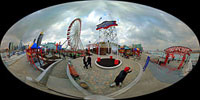The 4pi Steradian image

A 4pi Steradian image is an oval or circular shaped 2-dimensional (flat) image representing the full 360 x 180° 3-D sphere. This means that everything in all directions is visible to the observer: front to back and straight up and down.
The term Steradian is the “Standard International Unit” of solid angular measure. Just as there are 360 degrees or 2pi radians in a circle, there are 4pi Steradians in a sphere.
4pi Steradian images are derived from Equirectangular images using remapping software.
The equirectangular format is commonly outputted by software programs used to assemble panoramas taken with circular fisheye lenses. This format represents the full sphere by using a rectangular coordinate system to transform the angles of the sphere into an equally spaced grid representing 360 x 180°. The cartography maps of the World using the Mercator projection is a good example.
In an equirectangular image the vertical angles that approach the top (zenith) and bottom (nadir) become more distorted until the points at the zenith and nadir become lines stretched out along the top and bottom. Usually the top and bottom sections are cropped away to display a more pleasing panorama. A less distorted and more uniquely viewable 2D panoramic image of a 360° spherical world can be experienced in a 4pi Steradian remapping of the equirectangular image.
The oval shaped 4pi steradian image has a 2:1 proportion and resembles a cartography projection called the Hammer-Aitoff projection. There is less distortion of the zenith and nadir regions although horizontal and vertical lines are curved to fit within the oval.
With additional software processing, the longitudes and latitudes of the spherical image can be repositioned to created new perspectives that are quite fascinating to look at.
© Jook Leung 2.26.02